Have you ever wondered what makes a turtle different from a tortoise? These fascinating creatures are often confused due to their similar appearances. Read on to learn how to distinguish between the two, and to understand how you can help protect our tortoise and freshwater turtle species! You can also learn more about other fascinating wildlife species through our Wild Sarasota blog series, or on our Florida Wildlife webpage.
Who Are Turtles?
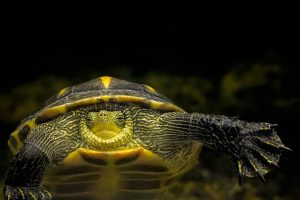
Turtles and tortoises belong to the order Testudines. As reptiles, they are ectothermic, and must rely on ambient heat sources such as the sun to regulate their body temperature.
They possess scaly skin, are vertebrates, breathe air using lungs, and usually lay eggs with leathery shells. What makes turtles and tortoises unique however, is the replacement of teeth with a beak, the location of their hip and shoulder girdles inside of their rib cage, and their bony shell.
Shell Stories
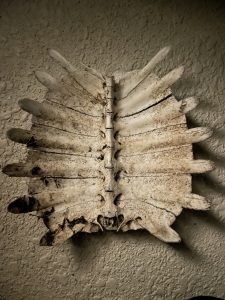
You may remember childhood cartoons depicting terrified turtles and tortoises speedily zipping away from danger, leaving their shells behind in the dust. This is purely fictional, as turtles are completely attached to their shells. In fact, a turtle’s bony shell is made of widened, modified rib bones that extend from its vertebrae! The structure of the shell also means that a turtle’s ribcage cannot expand when it breathes, so they need specialized muscles to pump air into their lungs.
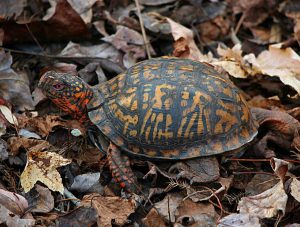
Just as we can feel when someone touches our back, turtles can feel through their shell. Turtle shells should never be punctured, drilled or carved into, or otherwise damaged. They also absorb UV light from the sun through their shells, which allows them to produce Vitamin D. Painting a turtle’s shell can prevent this vital physiological process from occurring.
A turtle’s shell can be described in three main parts- the carapace (top portion of the shell), the plastron (bottom portion of the shell), and the bridge, which connects the two.
Turtle or Tortoise?
The order Testudines can be thought of as the order of the turtles, so while all tortoises fall within this order, and as such, are technically turtles, all turtles are not tortoises. Read on to learn a few characteristics that can help you distinguish between turtles and tortoises.
Tortoises
Tortoises are primarily land-dwelling reptiles with dome-shaped shells and elephant-like legs that are well adapted for walking on land. Additionally, tortoises may also have a blunt shaped face and snout, dry, scaly skin, and dull colored shells. Mostly herbivorous, they are known for their longevity, sometimes living well over a hundred years. Tortoises are found in various habitats, including deserts, grasslands, and even forests, and are adapted to life in drier environments.
Florida’s Only Native Tortoise!
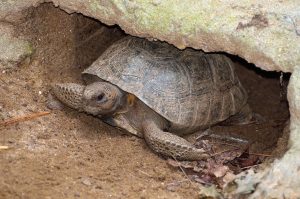
Among Florida’s over 30 native species of turtles, the gopher tortoise is our only native species of tortoise. Gopher tortoises use their specially adapted, shovel-like front feet and claws to dig burrows up to 6 feet deep and 15 feet long. These burrows are utilized by over 350 native species of vertebrate and invertebrate animals for shelter, hunting, nesting, and more!
Due to the threats they face and the critical services their burrows provide, gopher tortoises are designated as state-threatened, and are protected. It is illegal to handle or harass gopher tortoises and their burrows, and permits must be acquired to build where active burrows are present. If you find a gopher tortoise outside, do not put the tortoise in a body of water. They are not well-adapted living in aquatic environments. Learn more about gopher tortoises.
Freshwater Turtles
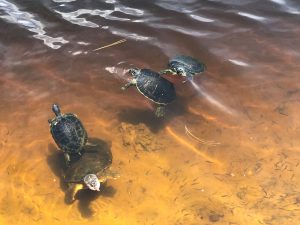
Generally when we say “turtle” here in the United States, we are referring to sea turtles and freshwater aquatic or semi-aquatic members of the order Testudines. These animals have streamlined shells, webbed feet, and are well-adapted for life in the water. Freshwater turtles inhabit fresh or brackish water environments, such as wetlands, estuaries, rivers, lakes, ponds, and seasonal or temporary bodies of water.
While they are excellent swimmers, turtles also spend some time on land while travelling to new habitats, searching for a mate, or creating their nests. Freshwater turtles can be carnivorous, herbivorous, or omnivorous, and their diets may vary at different stages of their lives.
How Can You Help Florida’s Turtles?
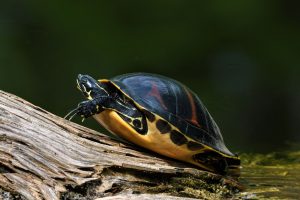
In both their aquatic and terrestrial habitats, turtles face quite a few threats. Keep reading to learn a few things that you can do to help protect them.
- One thing that we can all do here in Florida is drive a little slower! Observing speed limits and driving cautiously protects drivers and reduces road strikes that kill thousands of turtles and other wildlife every year. In areas where you frequently see wildlife, notice many dead animals in the road, or on roads that cut through wildlife habitat, it is wise to drive extra carefully!
- If you are someone who likes to help turtles across the road, ensure that it is safe to exit your vehicle-do not endanger your life. Always bring turtles across the road in the direction they were heading, be sure to hold turtles properly, and keep your hands out of reach of their mouths. Don’t forget to wash or sanitize your hands afterwards!
- You can also support efforts to conserve habitat, plant native aquatic vegetation in your neighborhood ponds, volunteer to help restore wetlands, and do your part to protect our water quality.

Keep Wildlife Wild!
Turtles are happiest in their habitats, where they have all of the things they need. Do not feed wild turtles and other wildlife. For some wildlife species, doing so is illegal, and most human foods are not healthy for wildlife. Feeding wildlife puts people and wildlife at risk.
If you are interested in getting a pet turtle, think twice! They can grow quite large, may live longer than us humans, and need specialized habitats and exposure to UV light to survive.
Do not release pet turtles into our local environments when you can no longer care for them. Instead, try calling a local, qualified wildlife or educational organization or find another qualified individual who can properly care for your pet.
As a reminder, it is illegal in Florida to take turtles from the wild to sell. There are several regulations that apply to specific turtle species in order to protect these amazing animals. Learn more about Florida’s rules and regulations here.
Learn More
Whether it’s the gopher tortoise creating extensive burrows that provide shelter for numerous other species or freshwater turtles contributing to nutrient cycling in aquatic ecosystems, these shelled reptiles work as ecosystem engineers and key players in preserving biodiversity.
Protecting and conserving turtles and tortoises is crucial to maintaining ecological integrity and ensuring a sustainable future for Florida’s diverse ecosystems. And, after all, who doesn’t love turtles!
Learn more about tortoises, freshwater turtles, box turtles, and some of the species that you can find in Sarasota County, with this Wild Sarasota: Turtle Talk webinar.
Read all our Wild Sarasota blogs HERE.
Interested in learning about sea turtles? Check out “Protecting Sea Turtles: Six Things You Can Do to Make a Difference”.
Learn more about terrapins and their conservation.
Learn all about Florida’s cooter species.
Sources:
Peter A. Meylan, Chelonian Research Foundation, 2006- Biology and Conservation of Florida’s Turtles– https://chelonian.org/wp-content/uploads/file/CRM%203/CRM_3_2006_Meylan_Florida_Turtles2.pdf
Kenneth L. Krysko, Kevin M. Enge, and Paul E. Moler, Florida Museum, Florida Fish and Wildlife Conservation Commission, 2011- Atlas of Amphibians and Reptiles in Florida– https://www.floridamuseum.ufl.edu/wp-content/uploads/sites/108/2021/01/herps_atlas_low.pdf
Florida Fish and Wildlife Conservation Commission- Profiles– https://myfwc.com/wildlifehabitats/profiles/#!categoryid=16760&subcategoryid=16808&status=
 1
1
